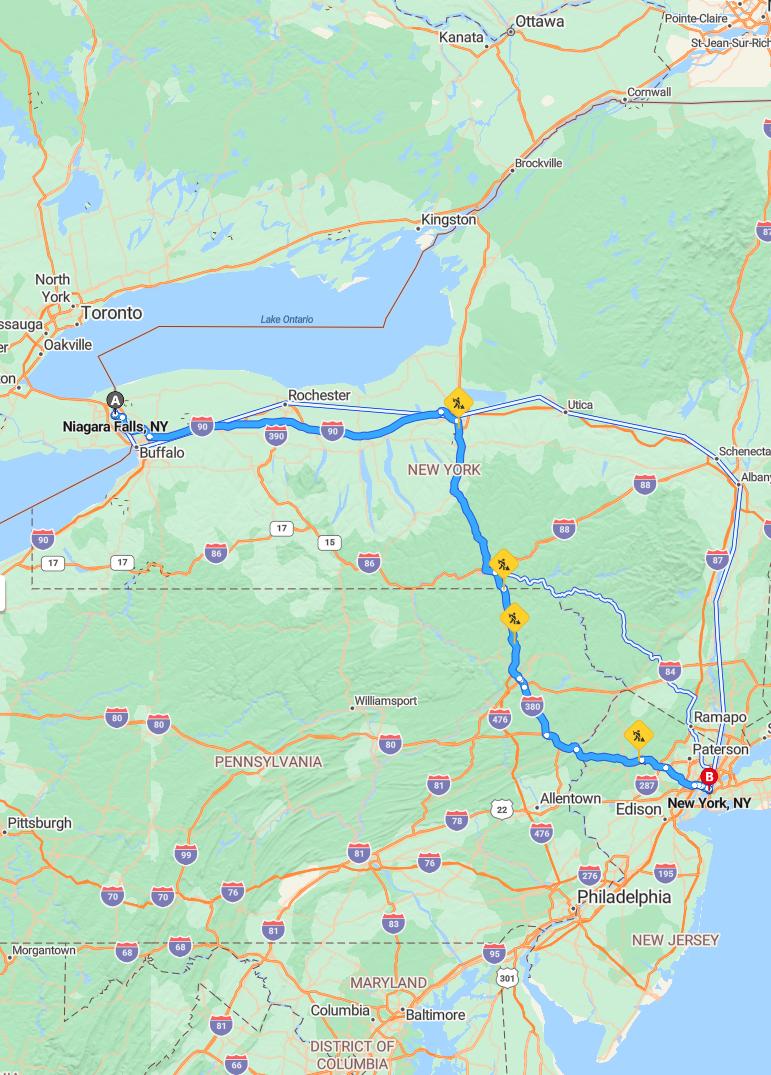Distance and estimated driving time
The drive from Niagara Falls to New York City covers approximately 410 miles, taking around 6 hours and 13 minutes. Travelers will typically follow major highways such as I-90 E and I-81 S for a smooth and efficient trip. Planning ahead for potential traffic or rest stops can help ensure a comfortable journey. Ultimately, this route provides a scenic and direct path from the scenic waterfalls to the bustling metropolis.
Driving route
Embarking on a road trip from Niagara Falls, NY to New York City offers a scenic journey through New York State's diverse landscapes. Starting at the iconic Niagara Falls, travelers can enjoy the breathtaking waterfalls before heading south to Buffalo, known for its rich history and vibrant arts scene. Continuing eastward, Rochester provides a blend of cultural attractions and historical sites, followed by Utica, renowned for its unique cuisine and outdoor activities. Finally, arriving in New York City, visitors are greeted by a bustling metropolis filled with iconic landmarks, world-class entertainment, and endless opportunities for exploration. This route seamlessly connects natural wonders and urban attractions, making for a memorable and enriching travel experience.

Best time to travel
The optimal time to drive from Niagara Falls to New York City is during the spring (April to June) and fall (September to November), when weather conditions are generally mild and pleasant. During these periods, travelers can enjoy minimal snow and rain, making for safer and more comfortable driving conditions. Summer months (July and August) tend to be busier due to tourists and school vacations, while winter driving (December to February) may pose challenges such as snow and icy roads, especially through upstate New York. Planning your trip in the shoulder seasons ensures a smoother journey, allowing you to appreciate the scenic route through Buffalo, Rochester, Utica, and eventually to New York City without weather-related disruptions.
Important highways and exits
Travelers heading from Niagara Falls to New York City typically take Interstate 90 (I-90), also known as the New York State Thruway, which provides a direct and efficient route. As you leave Niagara Falls, you'll merge onto I-190 south toward Buffalo, where exits for major highways like I-290 and I-990 are available for nearby destinations. Continuing east on I-90, you'll pass through Buffalo and Rochester, with important exits including those for I-490 and I-590, connecting to local areas. Approaching Utica and eventually New York City, you'll use the I-87 (the New York State Thruway), especially near Albany, until reaching the final stretch into the city via various local exits and connecting highways.
Scenic spots along the way
As you drive from Niagara Falls to New York City, you'll encounter several scenic spots worth exploring. Starting at the majestic Niagara Falls, visitors can witness the awe-inspiring waterfalls and vibrant nearby parks, offering breathtaking views and photo opportunities. Continuing south, Buffalo boasts beautiful waterfront parks and architecture along Lake Erie, perfect for a relaxing stroll. Further along the route, Rochester features the stunning High Falls and scenic parks, while Utica offers charming landscapes and historic sites. Finally, approaching New York City, travelers can enjoy the lush greenery of the Hudson River Valley, culminating in the bustling city skyline promising a memorable journey filled with scenic beauty.
Traffic conditions and congestion
Driving from Niagara Falls to New York City, travelers can expect varying traffic conditions along the route. The initial stretch from Niagara Falls through Buffalo generally experiences moderate flow, but congestion can increase during peak hours. As you approach Rochester and Utica, traffic tends to ease, although construction zones may cause minor delays. Once nearing New York City, congestion intensifies significantly, especially during evening rush hours, leading to potential delays on major highways.
Parking options in New York City
Parking options in New York City are diverse and plentiful, catering to different needs and budgets. Visitors can choose from numerous public parking garages and lots conveniently located throughout Manhattan and the surrounding boroughs. Street parking is available but often limited and requires understanding dynamic pricing and strict enforcement hours. Additionally, many areas offer parking apps and prepaid passes for easier access, making urban exploration more manageable for drivers.
Road safety tips
When driving from Niagara Falls to New York City, prioritizing safety is essential for a smooth journey. Always observe speed limits and stay attentive, especially during long stretches of highway driving. Make sure your vehicle is in good condition, with properly functioning brakes, tires, and lights, to prevent breakdowns or accidents. Additionally, take regular breaks to rest and stay alert, and keep your phone hands-free for emergencies to ensure a safe and enjoyable trip.
Toll information and costs
When driving from Niagara Falls to New York City, travelers should be aware of various tolls along the route. Tolls are primarily encountered on the New York State Thruway (Interstate 90 and 87), with fees varying depending on vehicle size and distance traveled. The typical cost for a standard passenger vehicle traveling the entire Thruway stretch from Buffalo to New York City ranges from approximately $25 to $35. It is advisable to use electronic toll collection systems such as E-ZPass for convenience and potential discounts, ensuring a smooth journey through the toll plazas.
Rest stops and fuel stations
When driving from Niagara Falls to New York City, there are several convenient rest stops and fuel stations along the route. In Niagara Falls and Buffalo, numerous gas stations and rest areas allow travelers to refuel and take a quick break before heading south. As you pass through Rochester and Utica, you'll find well-equipped rest stops with amenities such as food, restrooms, and picnic areas, ideal for a longer pause. Approaching New York City, most highways feature updated service plazas and fueling stations to ensure a comfortable and efficient journey until your arrival.
